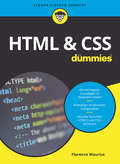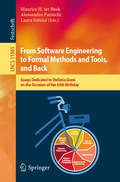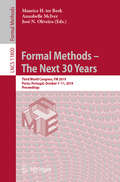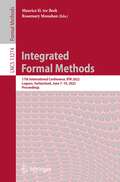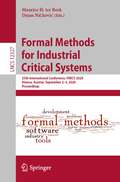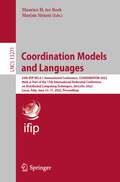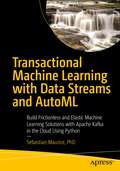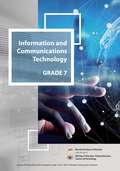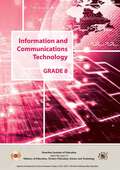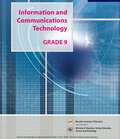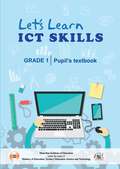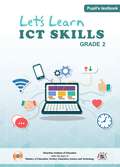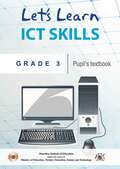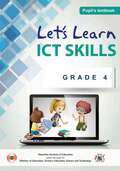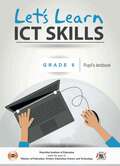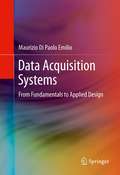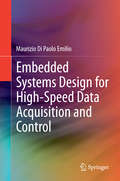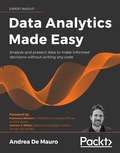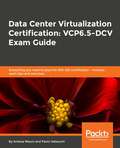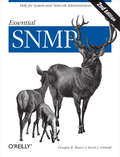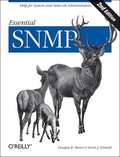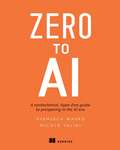- Table View
- List View
HTML und CSS für Dummies (Für Dummies)
by Florence MauriceAuch heute noch ist HTML & CSS die Basis aller Webseiten: Wer mehr möchte, als nur einen fertigen Websitebaukasten zu nutzen, kommt an HTML & CSS schwer vorbei. Egal, ob eine Webseite komplett neu aufgebaut werden soll oder, ob beim Einsatz eines Content Managementsystems individuelle Anpassungen vorgenommen werden sollen;ohne HTML & CSS ist dies nicht möglich. Florence Maurice erklärt Ihnen mit vielen Beispielen und Schritt für Schritt alle wichtigen Grundlagen, wie HTML funktioniert, wofür Sie CSS benötigen und wie Sie am Ende all dieses Wissen anwenden.
From Software Engineering to Formal Methods and Tools, and Back: Essays Dedicated to Stefania Gnesi on the Occasion of Her 65th Birthday (Lecture Notes in Computer Science #11865)
by Maurice H. ter Beek Alessandro Fantechi Laura SeminiThis volume was published in honor of Stefania Gnesi’s 65th birthday. The Festschrift volume contains 32 papers written by close collaborators and friends of Stefania and was presented to her on October 8, 2019 one-day colloquium held in Porto, Portugal, The Festschrift consists of eight sections, seven of which reflect the main research areas to which Stefania has contributed. Following a survey of Stefania's legacy in research and a homage by her thesis supervisor, these seven sections are ordered according to Stefania's life cycle in research, from software engineering to formal methods and tools, and back: Software Engineering; Formal Methods and Tools; Requirements Engineering; Natural Language Processing; Software Product Lines; Formal Verification; and Applications.
Formal Methods – The Next 30 Years: Third World Congress, FM 2019, Porto, Portugal, October 7–11, 2019, Proceedings (Lecture Notes in Computer Science #11800)
by Maurice H. ter Beek Annabelle McIver José N. OliveiraThis book constitutes the refereed proceedings of the 23rd Symposium on Formal Methods, FM 2019, held in Porto, Portugal, in the form of the Third World Congress on Formal Methods, in October 2019. The 44 full papers presented together with 3 invited presentations were carefully reviewed and selected from 129 submissions. The papers are organized in topical sections named: Invited Presentations; Verification; Synthesis Techniques; Concurrency; Model Checking Circus; Model Checking; Analysis Techniques; Specification Languages; Reasoning Techniques; Modelling Languages; Learning-Based Techniques and Applications; Refactoring and Reprogramming; I-Day Presentations.
Integrated Formal Methods: 17th International Conference, IFM 2022, Lugano, Switzerland, June 7–10, 2022, Proceedings (Lecture Notes in Computer Science #13274)
by Maurice H. ter Beek Rosemary MonahanThis book constitutes the refereed proceedings of the 17th International Conference on Integrated Formal Methods, IFM 2022, held in Lugano, Switzerland, in June 2022. The 14 full papers and 2 short papers were carefully reviewed and selected from 46 submissions. The papers are categorized into the following topical sub-headings: Invited Papers; Cooperative and Relational Verification; B Method; Time; Probability; learning and Synthesis; Security; Stats Analysis and Testing; PhD Symposium Presentations.
Formal Methods for Industrial Critical Systems: 25th International Conference, FMICS 2020, Vienna, Austria, September 2–3, 2020, Proceedings (Lecture Notes in Computer Science #12327)
by Maurice H. ter Beek Dejan NičkovićThis book constitutes the proceedings of the 25th International Workshop on Formal Methods for Industrial Critical Systems, FMICS 2020, which was held during September 2-3, 2020. The conference was planned to take place in Vienna, Austria. Due to the COVID-19 pandemic it changed to a virtual event.The 11 full papers presented in this volume were carefully reviewed and selected from 26 submissions. The papers are organized in topical sections as follows: Quantitative Analysis and Cyber-Physical Systems, Formal Verification of Industrial Systems, Temporal Logic and Model Checking. The book also contains a lengthy report on a Formal Methods Survey conducted on occasion of the 25th edition of the conference.
Coordination Models and Languages: 24th IFIP WG 6.1 International Conference, COORDINATION 2022, Held as Part of the 17th International Federated Conference on Distributed Computing Techniques, DisCoTec 2022, Lucca, Italy, June 13-17, 2022, Proceedings (Lecture Notes in Computer Science #13271)
by Maurice H. ter Beek Marjan SirjaniThis book constitutes the refereed proceedings of the 24th IFIP WG 6.1 International Conference on Coordination Models and Language, COORDINATION 2022, held in Lucca, Italy, in June 2022, as part of the 17th International Federated Conference on Distributed Computing Techniques, DisCoTec 2022. The 11 regular papers and one short paper presented in this book were carefully reviewed and selected from 22 submissions. COORDINATION provides a well-established forum for the growing community of researchers interested in coordination models and languages, architectures, verification and implementation techniques necessary to cope with the complexity induced by the demands of today's software development.
Online Dating as A Strategic Game
by Maurice Kwok-to Choi Kwok-Bun ChanBased on a study using online ethnography as the major research method, this book explains why and how men in Hong Kong use QQ--an online instant messenger--to "chase" women in mainland China, especially in the neighboring city of Shenzhen. Chasing women through QQ is a reciprocal exchange process during which the resources to be exchanged in the interaction are not negotiated. Rather, the men provide resources to the women, hoping for rewards in return that are not guaranteed. This characteristic of the exchange makes men who chase women through QQ very strategic in their action. They try to maximize the rewards and minimize the costs by adopting myriad strategies, such as constructing an attractive online identity by strategic self-presentation. The role of emotions in the exchange process is also examined. Men learn the emotional norms through the online forum, but sometimes it is difficult for them to control their emotions; some men fall in love when they are not supposed to. As it happens, they have failed to calculate the costs and rewards rationally in that they may provide too many resources to the women without getting enough rewards in return. This book provides original insights into the thought processes, motivations, desires, anxieties and risks of Hong Kong men seeking short-term sexual relations with women on the mainland. These insights are highly relevant to our understanding of the quickly evolving use of social media, a phenomenon of worldwide importance and deep implications.
Transactional Machine Learning with Data Streams and AutoML: Build Frictionless and Elastic Machine Learning Solutions with Apache Kafka in the Cloud Using Python
by Sebastian MauriceUnderstand how to apply auto machine learning to data streams and create transactional machine learning (TML) solutions that are frictionless (require minimal to no human intervention) and elastic (machine learning solutions that can scale up or down by controlling the number of data streams, algorithms, and users of the insights). This book will strengthen your knowledge of the inner workings of TML solutions using data streams with auto machine learning integrated with Apache Kafka. Transactional Machine Learning with Data Streams and AutoML introduces the industry challenges with applying machine learning to data streams. You will learn the framework that will help you in choosing business problems that are best suited for TML. You will also see how to measure the business value of TML solutions. You will then learn the technical components of TML solutions, including the reference and technical architecture of a TML solution. This book also presents a TML solution template that will make it easy for you to quickly start building your own TML solutions. Specifically, you are given access to a TML Python library and integration technologies for download. You will also learn how TML will evolve in the future, and the growing need by organizations for deeper insights from data streams. By the end of the book, you will have a solid understanding of TML. You will know how to build TML solutions with all the necessary details, and all the resources at your fingertips. What You Will Learn Discover transactional machine learning Measure the business value of TML Choose TML use cases Design technical architecture of TML solutions with Apache Kafka Work with the technologies used to build TML solutions Build transactional machine learning solutions with hands-on code together with Apache Kafka in the cloud Who This Book Is For Data scientists, machine learning engineers and architects, and AI and machine learning business leaders.
Information and Communications Technology class 7 - MIE
by Mauritius Institute of EducationThe Grade 7 ICT textbook for students in Mauritius is a comprehensive guide designed to facilitate a smooth transition from Grade 6, focusing on key competencies, knowledge, skills, attitudes, and values in Information and Communications Technology (ICT). The textbook's eight units cover diverse ICT topics, including computer operations, the Internet, word processing, spreadsheet, presentation, multimedia, and problem solving. Each unit is structured with activities, quick tests, summative exercises, and end-of-unit questions. An engaging feature is the introduction of an avatar named Tipiyu, providing guidance throughout the book. The curriculum emphasizes fundamental ICT principles, safety, ethics, and practical skills in areas such as programming using Scratch. The textbook aims to make learning accessible, empowering, and enjoyable for Grade 7 students, acknowledging the contributions of various stakeholders in its development.
Information and Communications Technology class 8 - MIE
by Mauritius Institute of EducationThe "Information and Communications Technology - Grade 8" textbook, published by the Mauritius Institute of Education in 2021, encompasses nine units covering a wide array of ICT topics. Aimed at Grade 8 students, it delves into fundamental aspects like computer operations, word processing, presentations, spreadsheets, internet usage, multimedia, health, safety, ethics, practical problem-solving, programming, and databases. Serving as a comprehensive guide, it equips students with a strong foundational understanding of ICT principles and skills crucial in today's world. The textbook's clarity and concise presentation facilitate easy comprehension, allowing students to grasp concepts effortlessly. With its detailed coverage and accessible language, this resource proves invaluable for students seeking to explore and comprehend the applications and significance of ICT in the modern era.
Information And Communications Technology class 9 - MIE
by Mauritius Institute of EducationThe Grade 9 ICT workbook is meticulously crafted to align with the National Curriculum Framework, recognizing the pivotal role of digital literacy in today's evolving landscape. With a strategic focus on technology's exponential growth, the workbook unfolds across nine comprehensive units, ranging from fundamental computer operations to practical problem-solving and programming. Through a learner-centric approach, the workbook amalgamates theoretical concepts with engaging practical activities, employing games, and exercises that foster hands-on learning experiences. Emphasizing continuous engagement, it encourages a year-long blend of theory and application. Symbolized guides like Tipiyu, carried over from previous grades, enrich the learning journey, while colored elements and symbols serve as aids, enhancing comprehension. Anchored in promoting ICT skills essential for a burgeoning knowledge society, this workbook primes students for the National Examination, nurturing their capacity to navigate digital environments, solve problems, and flourish in an increasingly tech-driven world.
Let's Learn ICT Skills - Pupil's Book class 1 - MIE
by Mauritius Institute of EducationThe ICT skills textbook, developed by the Mauritius Institute of Education in 2021, serves as a foundational guide for students to grasp essential computer competencies. Covering fundamental topics including the structure of a computer system, mouse proficiency, word processing, internet navigation, and multimedia tool utilization, the textbook facilitates a well-rounded understanding of ICT concepts. Through a series of engaging activities and assessments, students are encouraged to identify computer components, practice mouse manipulation, typing, and effectively navigate online platforms. Supported by comprehensive resources such as teachers' manuals and practical exercises, the textbook aligns with the National Curriculum Framework for Nine Year Continuous Basic Education, ensuring a structured and holistic approach to ICT education.
Let's Learn ICT Skills - Pupil's Book class 2 - MIE
by Mauritius Institute of EducationThe ICT Skills Guide by the Mauritius Institute of Education serves as an invaluable resource for educators, aligning with the National Curriculum Framework. It comprehensively covers essential computer literacy topics such as safety measures, software proficiency, and fundamental internet usage. Each unit within the guide delineates clear learning objectives and offers a balanced blend of theoretical concepts and hands-on activities, complemented by corresponding content in the accompanying textbook. With built-in evaluations, educators can effectively gauge student comprehension and progress. This guide proves instrumental in fostering robust ICT competencies among learners, providing a cohesive and structured approach to skill development within the educational framework.
Let's Learn ICT Skills - Pupil's Book class 3 - MIE
by Mauritius Institute of EducationThe Computer Fundamentals module provides a comprehensive introduction to the world of computing, covering essential concepts and practical skills. It begins with an overview of computers and their types, such as desktops, laptops, and tablets, along with the fundamental components comprising them. Learners explore file management techniques, spreadsheet basics, and word processing tasks, including document formatting and clip art insertion. Presentation skills are developed through creating PowerPoint slideshows. Internet usage dos and don'ts, web addresses, webpage access, saving, and printing are explained, while multimedia tasks in MS Paint are covered. Furthermore, the module emphasizes health, safety, and ethical considerations related to computer usage, highlighting potential health issues like neck and back pain, and eye strain. By encompassing both theoretical knowledge and practical skills, the module equips learners with a solid foundation in computer literacy essential for modern-day endeavors.
Let’s Learn ICT Skills - Pupil’s Book - class 4 - MIE
by Mauritius Institute of EducationThe Grade 4 ICT skills textbook, authored by the academic staff of the Mauritius Institute of Education, provides a comprehensive and accessible guide for students. The book covers essential topics such as computer operations, multimedia, word processing, presentation, spreadsheet, and Internet skills. Divided into units, the curriculum introduces students to the fundamentals of computer usage, including mouse and keyboard skills, desktop navigation, and window manipulation. It progresses to cover multimedia applications and practical exercises using software like Paint. The textbook further delves into word processing with Microsoft Word, file management, presentation creation with PowerPoint, and spreadsheet usage with Excel. The Internet unit introduces basic concepts and skills, guiding students on web browsing and online information retrieval. Each unit offers engaging activities, exercises, and teacher's notes, making the learning experience interactive and enjoyable for Grade 4 students.
Let's Learn ICT Skills - Pupil's Book - class 5 - MIE
by Mauritius Institute of EducationThe Grade 5 ICT skills textbook, released by the Mauritius Institute of Education in 2021, serves as a comprehensive guide for students, covering fundamental topics in computer literacy. The curriculum spans computer fundamentals, word processing, multimedia, presentation, spreadsheet, and internet skills. It provides in-depth insights into desktop elements and customization options, emphasizing efficient navigation through right-click menus and keyboard shortcuts. The word processing section focuses on Microsoft Office Word, offering practical demonstrations on inserting clip art, manipulating text, and incorporating tables. The multimedia chapter introduces graphics software using Paint.net, distinguishing between bitmap and vector graphics. The presentation unit utilizes Microsoft Office PowerPoint to teach advanced features such as layout changes, table insertion, and slide transitions. The spreadsheet module, employing Microsoft Office Excel, guides students through data manipulation, including worksheet management, cell formatting, and formula usage. The Internet section utilizes Firefox to instruct students on web browsing, tab management, and basic webpage interactions. With a hands-on approach and practical examples, this textbook aims to equip Grade 5 students with essential ICT skills for effective digital literacy.
Let’s Learn ICT Skills - Pupil’s Textbook class 6 - MIE
by Mauritius Institute of EducationThis Grade 6 ICT skills textbook comprehensively covers fundamental aspects of computer literacy. Beginning with Computer Fundamentals, it delves into hardware, software, and introduces various operating systems for computers and mobile devices. The Word Processing section advances students' skills, encompassing tasks like adding picture borders, utilizing spelling and grammar tools, and employing find and replace functions. Multimedia skills are honed through the creation and editing of drawings, movies, and presentations, integrating diverse media elements. The Presentation module guides students in editing slides, inserting media, and incorporating animations and hyperlinks. The Spreadsheet segment demonstrates advanced features, including data manipulation, formatting, and chart representation. The Internet section introduces email basics, covering composition, sending, replying, forwarding, and file attachments, while highlighting the advantages of email usage. Overall, the textbook provides a comprehensive foundation for Grade 6 pupils in mastering diverse ICT skills essential for today's digital world.
Data Acquisition Systems: From Fundamentals to Applied Design
by Maurizio Di Paolo EmilioThis book describes the fundamentals of data acquisition systems, how they enable users to sample signals that measure real physical conditions and convert the resulting samples into digital, numeric values that can be analyzed by a computer. The author takes a problem-solving approach to data acquisition, providing the tools engineers need to use the concepts introduced. Coverage includes sensors that convert physical parameters to electrical signals, signal conditioning circuitry to convert sensor signals into a form that can be converted to digital values and analog-to-digital converters, which convert conditioned sensor signals to digital values. Readers will benefit from the hands-on approach, culminating with data acquisition projects, including hardware and software needed to build data acquisition systems.
Embedded Systems Design for High-Speed Data Acquisition and Control
by Maurizio Di Paolo EmilioThis book serves as a practical guide for practicing engineers who need to design embedded systems for high-speed data acquisition and control systems. A minimum amount of theory is presented, along with a review of analog and digital electronics, followed by detailed explanations of essential topics in hardware design and software development. The discussion of hardware focuses on microcontroller design (ARM microcontrollers and FPGAs), techniques of embedded design, high speed data acquisition (DAQ) and control systems. Coverage of software development includes main programming techniques, culminating in the study of real-time operating systems. All concepts are introduced in a manner to be highly-accessible to practicing engineers and lead to the practical implementation of an embedded board that can be used in various industrial fields as a control system and high speed data acquisition system.
Data Analytics Made Easy: Use machine learning and data storytelling in your work without writing any code
by Andrea De Mauro Francesco Marzoni Andrew J. WalterMake informed decisions using data analytics, machine learning, and data visualizationsKey FeaturesTake raw data and transform it to add value to your organizationLearn the art of telling stories with your data to engage with your audienceApply machine learning algorithms to your data with a few clicks of a buttonBook DescriptionData analytics has become a necessity in modern business, and skills such as data visualization, machine learning, and digital storytelling are now essential in every field. If you want to make sense of your data and add value with informed decisions, this is the book for you. Data Analytics Made Easy is an accessible guide to help you start analyzing data and quickly apply these skills to your work. It focuses on how to generate insights from your data at the click of a few buttons, using the popular tools KNIME and Microsoft Power BI. The book introduces the concepts of data analytics and shows you how to get your data ready and apply machine learning algorithms. Implement a complete predictive analytics solution with KNIME and assess its level of accuracy. Create impressive visualizations with Microsoft Power BI and learn the greatest secret in successful analytics – how to tell a story with your data. You'll connect the dots on the various stages of the data-to-insights process and gain an overview of alternative tools, including Tableau and H20 Driverless AI. By the end of this book, you will have learned how to implement machine learning algorithms and sell the results to your customers without writing a line of code.What you will learnUnderstand the potential of data and its impact on any businessInfluence business decisions with effective data storytelling when delivering insightsUse KNIME to import, clean, transform, combine data feeds, and automate recurring workflowsLearn the basics of machine learning and AutoML to add value to your organizationBuild, test, and validate simple supervised and unsupervised machine learning models with KNIMEUse Power BI and Tableau to build professional-looking and business-centric visuals and dashboardsWho this book is forWhether you are working with data experts or want to find insights in your business' data, you'll find this book an effective way to add analytics to your skill stack.No previous math, statistics, or computer science knowledge is required.
Data Center Virtualization Certification: Everything you need to achieve 2V0-622 certification – with exam tips and exercises
by Andrea Mauro Paolo ValsecchiDeploy and configure vSphere infrastructure and learn to effectively create and administer vSphere virtual machinesKey FeaturesImplement advanced network virtualization techniquesConfigure and administer vSphere high availabilityEnhance your data center virtualization skills with practice questions and mock testsBook DescriptionThis exam guide enables you to install, configure, and manage the vSphere 6.5 infrastructure in all its components: vCenter Server, ESXi hosts, and virtual machines, while helping you to prepare for the industry standard certification.This data center book will assist you in automating administration tasks and enhancing your environment’s capabilities. You will begin with an introduction to all aspects related to security, networking, and storage in vSphere 6.5. Next, you will learn about resource management and understand how to back up and restore the vSphere 6.5 infrastructure. As you advance, you will also cover troubleshooting, deployment, availability, and virtual machine management. This is followed by two mock tests that will test your knowledge and challenge your understanding of all the topics included in the exam.By the end of this book, you will not only have learned about virtualization and its techniques, but you’ll also be prepared to pass the VCP6.5-DCV (2V0-622) exam.What you will learnDeploy and configure vSphere infrastructureCreate and administer vSphere virtual machinesOptimize, secure, and troubleshoot all vSphere componentsImplement vSphere HA on a vSAN clusterUnderstand how to back up and restore your vSphere 6.5 infrastructureTest your understanding of key concepts required through sample questionsWho this book is forIf you are interested in achieving Data Center Virtualization certification, this is the book is for you. You will also benefit from this book if you are a system administrator or network engineer. Some prior knowledge of virtualization can assist you in understanding key concepts covered in the book.
Essential SNMP
by Douglas Mauro Kevin SchmidtSimple Network Management Protocol (SNMP) provides a "simple" set of operations that allows you to more easily monitor and manage network devices like routers, switches, servers, printers, and more. The information you can monitor with SNMP is wide-ranging--from standard items, like the amount of traffic flowing into an interface, to far more esoteric items, like the air temperature inside a router. In spite of its name, though, SNMP is not especially simple to learn. O'Reilly has answered the call for help with a practical introduction that shows how to install, configure, and manage SNMP. Written for network and system administrators, the book introduces the basics of SNMP and then offers a technical background on how to use it effectively. Essential SNMP explores both commercial and open source packages, and elements like OIDs, MIBs, community strings, and traps are covered in depth. The book contains five new chapters and various updates throughout. Other new topics include: Expanded coverage of SNMPv1, SNMPv2, and SNMPv3 Expanded coverage of SNMPc The concepts behind network management and change management RRDTool and Cricket The use of scripts for a variety of tasks How Java can be used to create SNMP applications Net-SNMP's Perl module The bulk of the book is devoted to discussing, with real examples, how to use SNMP for system and network administration tasks. Administrators will come away with ideas for writing scripts to help them manage their networks, create managed objects, and extend the operation of SNMP agents. Once demystified, SNMP is much more accessible. If you're looking for a way to more easily manage your network, look no further than Essential SNMP, 2nd Edition.
Essential SNMP, 2nd Edition
by Douglas Mauro Kevin SchmidtSimple Network Management Protocol (SNMP) provides a "simple" set of operations that allows you to more easily monitor and manage network devices like routers, switches, servers, printers, and more. The information you can monitor with SNMP is wide-ranging--from standard items, like the amount of traffic flowing into an interface, to far more esoteric items, like the air temperature inside a router. In spite of its name, though, SNMP is not especially simple to learn. O'Reilly has answered the call for help with a practical introduction that shows how to install, configure, and manage SNMP. Written for network and system administrators, the book introduces the basics of SNMP and then offers a technical background on how to use it effectively. Essential SNMP explores both commercial and open source packages, and elements like OIDs, MIBs, community strings, and traps are covered in depth. The book contains five new chapters and various updates throughout. Other new topics include: Expanded coverage of SNMPv1, SNMPv2, and SNMPv3 Expanded coverage of SNMPc The concepts behind network management and change management RRDTool and Cricket The use of scripts for a variety of tasks How Java can be used to create SNMP applications Net-SNMP's Perl module The bulk of the book is devoted to discussing, with real examples, how to use SNMP for system and network administration tasks. Administrators will come away with ideas for writing scripts to help them manage their networks, create managed objects, and extend the operation of SNMP agents. Once demystified, SNMP is much more accessible. If you're looking for a way to more easily manage your network, look no further than Essential SNMP, 2nd Edition .
Essential SNMP, 2nd Edition
by Douglas Mauro Kevin SchmidtSimple Network Management Protocol (SNMP) provides a "simple" set of operations that allows you to more easily monitor and manage network devices like routers, switches, servers, printers, and more. The information you can monitor with SNMP is wide-ranging--from standard items, like the amount of traffic flowing into an interface, to far more esoteric items, like the air temperature inside a router. In spite of its name, though, SNMP is not especially simple to learn. O'Reilly has answered the call for help with a practical introduction that shows how to install, configure, and manage SNMP. Written for network and system administrators, the book introduces the basics of SNMP and then offers a technical background on how to use it effectively. Essential SNMP explores both commercial and open source packages, and elements like OIDs, MIBs, community strings, and traps are covered in depth. The book contains five new chapters and various updates throughout. Other new topics include: Expanded coverage of SNMPv1, SNMPv2, and SNMPv3 Expanded coverage of SNMPc The concepts behind network management and change management RRDTool and Cricket The use of scripts for a variety of tasks How Java can be used to create SNMP applications Net-SNMP's Perl module The bulk of the book is devoted to discussing, with real examples, how to use SNMP for system and network administration tasks. Administrators will come away with ideas for writing scripts to help them manage their networks, create managed objects, and extend the operation of SNMP agents. Once demystified, SNMP is much more accessible. If you're looking for a way to more easily manage your network, look no further than Essential SNMP, 2nd Edition .
Zero to AI: A non-technical, hype-free guide to prospering in the AI era
by Gianluco Mauro Nicolo ValigiSummary How can artificial intelligence transform your business? In Zero to AI, you&’ll explore a variety of practical AI applications you can use to improve customer experiences, optimize marketing, help you cut costs, and more. In this engaging guide written for business leaders and technology pros alike, authors and AI experts Nicolò Valigi and Gianluca Mauro use fascinating projects, hands-on activities, and real-world explanations to make it clear how your business can benefit from AI. Purchase of the print book includes a free eBook in PDF, Kindle, and ePub formats from Manning Publications. About the technology There&’s no doubt that artificial intelligence has made some impressive headlines recently, from besting chess and Go grand masters to producing uncanny deep fakes that blur the lines of reality. But what can AI do for you? If you want to understand how AI will impact your business before you invest your time and money, this book is for you. About the book Zero to AI uses clear examples and jargon-free explanations to show the practical benefits of AI. Each chapter explores a real-world case study demonstrating how companies like Google and Netflix use AI to shape their industries. You begin at the beginning, with a primer on core AI concepts and realistic business outcomes. To help you prepare for the transition, the book breaks down a successful AI implementation, including advice on hiring the right team and making decisions about resources, risks, and costs. What's inside Identifying where AI can help your organization Designing an AI strategy Evaluating project scope and business impact Using AI to boost conversion rates, curate content, and analyze feedback Understanding how modern AI works and what it can/can&’t do About the reader For anyone who wants to gain an understanding of practical artificial intelligence and learn how to design and develop projects with high business impact. About the author Gianluca Mauro and Nicolò Valigi are the cofounders of AI Academy, a company specializing in AI trainings and consulting. Table of Contents: 1. An introduction to artificial intelligence PART 1 - UNDERSTANDING AI 2. Artificial intelligence for core business data 3. AI for sales and marketing 4. AI for media 5. AI for natural language 6. AI for content curation and community building PART 2 - BUILDING AI 7. Ready—finding AI opportunities 8. Set—preparing data, technology, and people 9. Go—AI implementation strategy 10. What lies ahead
